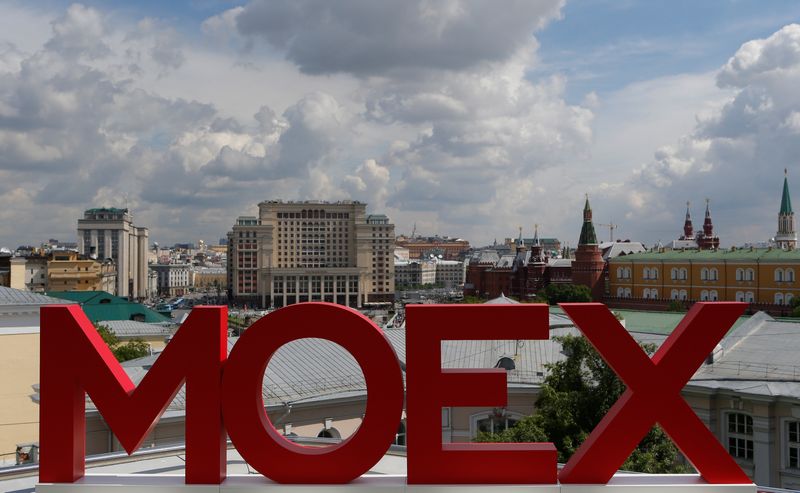Russian stocks to pare some heavy losses by year-end – Reuters poll
2022.08.24 10:02

FILE PHOTO: The letters MOEX are pictured at the Moscow Exchange, with the Kremlin and the Four Seasons Hotel seen in the background, in Moscow, Russia, May 26, 2017. REUTERS/Segrei Karpukhin
(This content was produced in Russia where the law restricts coverage of Russian military operations in Ukraine)
By Andrey Ostroukh
MOSCOW (Reuters) – Russia’s stock market will pare some of its heavy 2022 losses by the end of the year, according to a Reuters poll of ten market experts, having fallen sharply after Moscow dispatched troops into Ukraine, triggering sweeping western sanctions.
Russian stocks had been on the rise since the second quarter of 2020 and hit a record high in October 2021, before a massive sell-off erased 56% of the rouble-denominated market capitalisation in the first two months of 2022.
By the end of this year, the benchmark MOEX rouble-based index is expected to have recovered to 2,500, 12.2% above Monday’s close of 2,228.11 but sharply below the 4,350 predicted by the last Reuters Russian market poll published in December.
The MOEX reached a record peak of 4,292.68 in mid-October last year.
This year, the market landscape has changed drastically since Moscow began what it calls a “special military operation” in Ukraine on Feb. 24. Risk aversion has soared but some fundamentals, such as a strong price of oil, Russia’s main export, have underpinned the market.
Russia also banned foreign investors from trading stocks, shutting off external liquidity, and a surging number of domestic retail investors have become the main driving power on the market battered by unprecedented western sanctions.
Moscow Exchange, Russia’s largest bourse, is now considering allowing investors from designated “friendly” countries that imposed no sanctions against Russia to return to the market. Analysts warn this could hammer stocks.
“The main risk for the Russian stock market in the coming months is a possible return of non-residents from ‘friendly’ countries, which are fewer than investors from ‘unfriendly’ countries, but still can begin selling shares blocked since February of this year,” said Elena Kozhukhova, an analyst at brokerage Veles Capital.
Forecasts for the MOEX index reading in late 2023 in the August Reuters poll varied from 2,400 to 3,700.
The dollar-based RTS index was forecast to trade at 1,279 points by year-end, up about 9% from Monday’s close of 1,173.79.
Gazprombank equity strategist Erik DePoy said chances of another major sell-off were low as the Russian equity market is essentially disconnected from global market sentiment, with the exception of oil and metals prices.
“Assuming no other major external shocks, there seem to be few downside catalysts,” DePoy said.
Analysts also saw some upside for the Russian market in hopes relations between Moscow and the West won’t worsen further.
The impact of sanctions risks should be priced in by the year-end and some easing in geopolitical risks is likely, said Natalia Milchakova, a leading analyst at Freedom Finance Global.
“Risks are mostly skewed to the upside as we hope that the geopolitical situation will trend towards diplomacy instead of force,” said Otkritie Investment analyst Andrey Kochetkov.
(Other stories from the Reuters Q3 global stock markets poll package:)
(Reporting and polling by Andrey Ostroukh; Editing by Jan Harvey)








